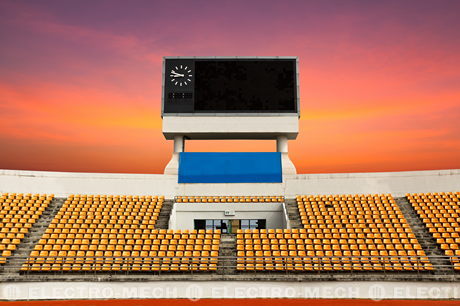
LED scoreboards have come a long way in the years since the technology has become reliable and even surpassed the competition in performance. Electronic sings in general have all benefited from the technological improvement, especially the scoreboard video display. In the creation and fabrication of these scoreboards, a general understanding of the production tools and processes helps appreciate these complex tools often taken for granted by sports fans.
The first component needed is the actual skeleton of the board; what the entire shape will be when its done and what are all the components to fit into. There are realistic limitations to the breadboard, for instance you can’t expect to make it as thin as a sheet of paper. Once an idea exists on the dimensions and a suitable sized board is secured, the first set toward building an LED scoreboard is made.
As with most electronic signs these days, LED’s are the light source of choice. LED’s for scoreboard use are generally seven segmented displays with various LED lights embedded into them. Depending on the number of digits you wish to display, the number of individual seven segmented LED panels will vary, since one is needed per digit. All of these are wired into the guts within the board itself, which contains the most complex parts.
Within the board, what actually handles most of the hard work is the motherboard, similar to what you’ll find in a computer. The resistors to focus electrical current and everything on the board to handle and direct the flow of electrons to get the intended pattern of lights to be displayed. Timers and other peripherals control things from there, guiding the signals and, through a series of electrical impules, everything from the score to the clock ticking down are displayed.
Scoreboard video displays are relatively new to the scoreboard landscape, with most being very similar to the digital billboards and electronic signs that have become popular. These are still LED Scoreboards, some being entirely built from intricate LED paneling far more complex than the seven segemented variety that are used exclusively for numbers.
Where LED scoreboards and other electronic signs that use the more involved circuitry of a scoreboard video display benefits the most are the gains made in processor technology that allows for greater refresh rates on screens as well as improvements in the bulb technology, allowing a whole slew of various colors of light to be displayed based on the intensity of electrical current. As technology has evolved in one field, other fields have made it a habit to also work for gains, and the LED scoreboards have not been neglected in the evolutionary process. With new high definition displays making headway into several stadiums, the impact high definition video has had on society is easily felt. Without improvements in television and video professors and image filters, the demand for such gains in technology would have been non-existent.
Less than 2 decades ago, production technology for scoreboards was simply a timer, some wires and a few light bulbs. How far we’ve come.
